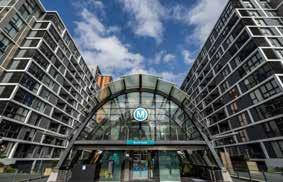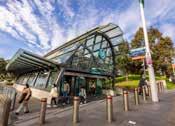MACQUARIE PARK
CONNECTING OUR COMMUNITY


CONNECTING OUR COMMUNITY

What if there was a place to work that was surrounded by greenery, shared by inspiring minds and easy to access?
Significant investment in public transport makes this increasingly possible in Macquarie Park, Sydney: Australia’s original innovation district.
Australia’s first autonomous Metro rail line opened in 2019, connecting three stations in Macquarie Park with Chatswood to the south, and Epping and suburbs to the north-west.

Sydney Metro had an immediate impact at Macquarie University, Macquarie Park and North Ryde: reducing traffic, connecting our community and changing the demographic of the people who are based here.
The Sydney Metro network will expand significantly in 2024.
New tunnels beneath Sydney Harbour will link Macquarie Park directly to the city for the first time, creating a single line from Tallawong in the north-west, through Macquarie Park, south to the city and Sydenham.
From 2024 you will be able to get a direct Metro from Barangaroo to Macquarie Park in just 18 minutes, with a train every 4 minutes during peak times.
A multi-billion-dollar investment in public transport, Sydney Metro represents the most significant change in Macquarie Park for a generation.
This new report from Connect Macquarie Park Innovation District aims to increase awareness of the forthcoming opportunity the extension of Sydney Metro represents, and to provide new insights.
“Get ready for more Metro, Macquarie Park” will examine:
• What happened in Macquarie Park when Sydney Metro stage one opened in 2019


Macquarie Park’s new 30-minute commute catchment area from 2024
Strategies and tips to help our community get ready for more Metro, and make the most of this opportunity.
This new report will be a useful resource for HR teams at leading local employers, economic development and investment attraction teams within Government, plus developers building and promoting the Macquarie Park of the future.
Acting as a unified voice for Macquarie Park while creating valuable connections across our community of members, Connect MPID provides:
• Data, research and Park-wide benchmarking
• Advocacy and thought leadership
• A member-wide community of practice
• Practical tools and resources
A dedicated Macquarie Park story-telling channel to highlight success.
Connect Macquarie Park Innovation District is a unique partnership between employers, landowners, Macquarie University and two levels of Government, who are working together to take our area forward as a world-leading innovation district. info@connectmpid.com.au


When the first stage of Sydney Metro opened in 2019, thousands of Sydneysiders flocked to try the new service. Metro had an immediate impact around Macquarie University, Macquarie Park and North Ryde stations: reducing traffic, connecting our community and changing the demographic of the people who are attracted here.
Data from counters on the M2 motorway at North Ryde show that traffic volumes dropped when the first stage of Sydney Metro opened in May 2019 – and remain below pre-Metro levels today.
According to analysis by AECOM, 4,000 fewer vehicles were passing Macquarie Park on average per weekday after the Metro opened. This significant change follows year-on-year growth in the number of vehicles using the M2 at this location.
From April to September 2022following the construction of Metro, the global pandemic, and changes to the way people work – traffic at Macquarie Park has remained 5% below pre-Metro levels, reducing congestion in our area.
Sydney Metro is acting as a catalyst for more people to live within walking distance of a station within Macquarie Park.
Our residential population increased by more than a third in the five years to 2021, to a total of 11,071 people.

At North Ryde a new, blue, pedestrian bridge has been built to connect a planned 5,000 new residents at Lachlan’s Line directly to Metro services. More than 2,700 homes will be built at the nine hectare site.


Re-zoning on Herring Road has created new neighbourhoods clustered around
Macquarie University Metro station. The “Midtown Mac Park” masterplan aims to be ‘100% walkable’, with homes, a school, parkland and a swimming pool within a 500m walk from Macquarie University Metro station.
86% of Macquarie Park residents now live in apartments, 70% were born overseas, and 60% are tertiary qualified (2.5 x the State average). About a fifth work in our local area.

Since the pandemic, commuters have returned to Sydney Metro Northwest faster than Sydney’s other suburban rail lines. The change in average daily patronage as a percent of pre-pandemic levels is higher at Macquarie University Metro station than at Parramatta, or Town Hall station in Sydney.

There were also more weekend trips on the Northwest line, including to destinations like Macquarie Centre.
Investment in public transport has seen Macquarie University become a campus not just for Sydney’s north, but for Sydney’s north and west.

Around 20,000 people travel to Macquarie University campus every day. 14,000 of them now come from the north and west, places which are connected by investment in public transport:
• The Hills Shire Hornsby
• Ku-ring-gai
• Blacktown
• Paramatta

"The NSW Government’s investment in transport infrastructure has been fundamental in enabling the growth of Macquarie Park, and its connection with the north and north-west”
Eric Knight, Executive Dean, Macquarie Business School
GET READY FOR MORE METRO
12 km from Sydney CBD
3 stations on Australia’s first Metro system
42% use public transport, walk or cycle to work in Macquarie Park
69% of Macquarie Park people find it easy to get here
Top 3 reasons behind Macquarie Park workers’ travel choice

58% of Sydneysiders support more density near and above train stations
24% of Macquarie Park people believe infrastructure is not keeping up with growth
WHEN SYDNEYSIDERS MOVE HOUSE, PROXIMITY TO PUBLIC TRANSPORT IS THEIR MOST IMPORTANT CONSIDERATION more than the size of the house, proximity to family, work or good schools

This report identifies the boost in access Sydney Metro represents. Employers should prepare now to bring more people to Macquarie Park with briefings to existing employees, new talent attraction plans and incentives for behaviour change. For example, a commuter expo was held on Thomas Holt Drive in the lead up to Sydney Metro stage one opening in 2019.
Public space must be ready to accommodate more people walking to Metro stations in Macquarie Park. This is a role for local Government, State Government and landowners. For example in Camden, London, $65m has been spent increasing public space, upgrading footpaths and managing traffic around new “Crossrail” train stations to meet forecast pedestrian demand.
Stakeholders in Macquarie Park should work together to seek further accessibility improvements for our area. This could range from sharing commuter data and intelligence, to aligning advocacy priorities. For example, jointly advocating for the delivery of a modest extension to the existing Metro line at Tallawong to the Western Sydney Airport Metro line at St Mary’s would connect Macquarie Park to the new Western Sydney International Airport.
Transport planning theory suggests most people want to commute for about an hour each day – or half an hour each way – and will adjust where they work or how they get there to be able to do so.
The expansion of Sydney Metro will create a new catchment area for Macquarie Park, with an increase in talent available within a 30 minute trip, as this new analysis from Connect Macquarie Innovation District reveals.
While improvements to planning, transport and technology have meant people are able to travel further, and more quickly – for example by Metro – the amount of time spent commuting remains constant.
Italian physicist Cesare Marchetti found people all over the world will commute for about one hour each day, (or half an hour each way) and will adjust their lives – including changing where they work or where they live – to meet this ‘travel time budget’.
The historic walking city spread out only 2-4km across, the tram city about 10km and the steam train city about 20km, before the car city went 40-50km out. All were “30-minute cities”.
The expansion of Sydney Metro services puts Macquarie Park at the centre of a new 30-minute catchment, with access to new localities of talent.
Source: Marchetti, C (1994) “Anthropological invariants in travel behaviour”
Source: NSW Government (2020) “Sydney Metro Corporate Plan 19-21”
NSW Government (2023) “Sydney Trains timetables”
Analysis assumes 5 minute transfer between lines on a morning peak weekday service.
As people return to offices, we are seeing an uneven demand on the transport network across the week and uneven economic activity in precincts.
Important city shaping projects are under construction, with more on the way. This includes major road and transport upgrades that may impact how your employees commute to the office.
To achieve a return to offices that is more sustainable in the longer term, we all play a role in increasing the use of public and active transport, optimising hybrid working arrangements, and encouraging off-peak travel.
The Travel Choices Program
• The Travel Choices program is delivering a Behavioural Science led approach that makes it easier for organisations to support employees with positive journeys to the office.

• This approach focuses on implementing small but powerful behavioural nudges, that have been developed with insights from in-depth behavioural research with Sydney workers and commuters.
We meet with you to understand your business’ unique context and objectives.
We design simple, low-cost behavioural nudges with you, ensuring they support your employees with positive journeys to the office.
We provide expert advice and ongoing support to help you implement nudges, and continue to create behaviour change within your business.
The Travel Choices team can work closely with your business or organisation to provide expert guidance and ongoing support.
To get involved contact: Travel Choices Program travelchoices@transport.nsw.gov.au

It’s time for your workplace to prepare for the arrival of more Metro services in Macquarie Park, and to make the most of this opportunity. The team at Connect Macquarie Park Innovation District and the Travel Choices Program at Transport for NSW are available to help you. Here’s some ideas to help you get started:

ORGWARE
Brief your leaders: Are your leadership team aware of the Sydney Metro opportunity, and aligned on how best to make the most of it?
Could your talent acquisition strategy target new catchment areas?
Consider a workplace travel survey or focus group, to understand how your people are commuting now. Our annual park-wide census, “Ask Macquarie Park” will help you. Re-visit your flexible working policy.
HARDWARE
Prepare your workplace:
Will Metro lead to more people coming to your workplace?
Do you have the facilities to encourage their journey? (Changes to parking, end of trip facilities, journey planning resources)
Could changes to how your people travel reduce demand, and potential costs, e.g. car parking and parking FBT?
Is your office travel access guide up to date?
SOFTWARE
Prepare your people:
It’s time to share the good news with your employees!
Use Connect MPID’s “More Metro” campaign pack to communicate the opportunity in an eyecatching and engaging way. Consider an employee briefing, or a fun Sydney Metro themed activation.
Incentivise staff to try the service for themselves.
Highlight the time existing commuters will get back in their day with the new service.
Share your travel access guide, and provide access to public transport trip planners.
CONTACT US TO DISCOVER MORE:
info@connectmpid.com.au
www.connectmpid.com.au
Connect Macquarie Park
Innovation District
1 Lyonpark Road, Macquarie Park, NSW, 2113 connectmpid.com.au
info@connectmpid.com.au
OUR MEMBERS, WORKING TOGETHER FOR MACQUARIE PARK
OUR AFFILIATES
